Information Security Assignment 1: Annotated Bibliography & Outline
VerifiedAdded on 2020/04/21
|11
|3495
|470
Homework Assignment
AI Summary
This assignment, completed by Dhillon Dilpreet Kaur, focuses on information security, comprising an annotated bibliography and a term paper outline. Part A involves a revised thesis statement discussing the pros and cons of information security, followed by APA-formatted citations and annotations f...
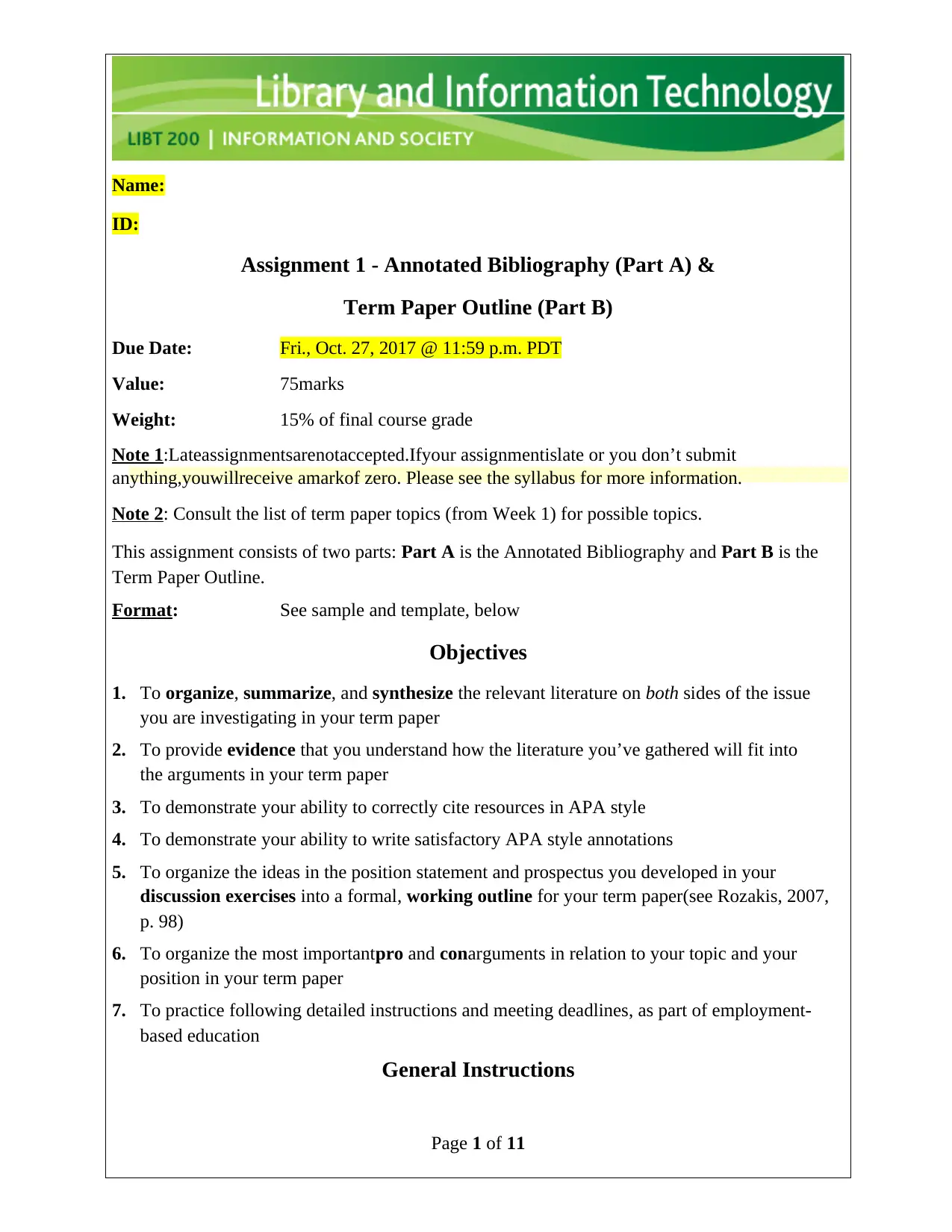
Name:
ID:
Assignment 1 - Annotated Bibliography (Part A) &
Term Paper Outline (Part B)
Due Date: Fri., Oct. 27, 2017 @ 11:59 p.m. PDT
Value: 75marks
Weight: 15% of final course grade
Note 1:Lateassignmentsarenotaccepted.Ifyour assignmentislate or you don’t submit
anything,youwillreceive amarkof zero. Please see the syllabus for more information.
Note 2: Consult the list of term paper topics (from Week 1) for possible topics.
This assignment consists of two parts: Part A is the Annotated Bibliography and Part B is the
Term Paper Outline.
Format: See sample and template, below
Objectives
1. To organize, summarize, and synthesize the relevant literature on both sides of the issue
you are investigating in your term paper
2. To provide evidence that you understand how the literature you’ve gathered will fit into
the arguments in your term paper
3. To demonstrate your ability to correctly cite resources in APA style
4. To demonstrate your ability to write satisfactory APA style annotations
5. To organize the ideas in the position statement and prospectus you developed in your
discussion exercises into a formal, working outline for your term paper(see Rozakis, 2007,
p. 98)
6. To organize the most importantpro and conarguments in relation to your topic and your
position in your term paper
7. To practice following detailed instructions and meeting deadlines, as part of employment-
based education
General Instructions
Page 1 of 11
ID:
Assignment 1 - Annotated Bibliography (Part A) &
Term Paper Outline (Part B)
Due Date: Fri., Oct. 27, 2017 @ 11:59 p.m. PDT
Value: 75marks
Weight: 15% of final course grade
Note 1:Lateassignmentsarenotaccepted.Ifyour assignmentislate or you don’t submit
anything,youwillreceive amarkof zero. Please see the syllabus for more information.
Note 2: Consult the list of term paper topics (from Week 1) for possible topics.
This assignment consists of two parts: Part A is the Annotated Bibliography and Part B is the
Term Paper Outline.
Format: See sample and template, below
Objectives
1. To organize, summarize, and synthesize the relevant literature on both sides of the issue
you are investigating in your term paper
2. To provide evidence that you understand how the literature you’ve gathered will fit into
the arguments in your term paper
3. To demonstrate your ability to correctly cite resources in APA style
4. To demonstrate your ability to write satisfactory APA style annotations
5. To organize the ideas in the position statement and prospectus you developed in your
discussion exercises into a formal, working outline for your term paper(see Rozakis, 2007,
p. 98)
6. To organize the most importantpro and conarguments in relation to your topic and your
position in your term paper
7. To practice following detailed instructions and meeting deadlines, as part of employment-
based education
General Instructions
Page 1 of 11
Paraphrase This Document
Need a fresh take? Get an instant paraphrase of this document with our AI Paraphraser
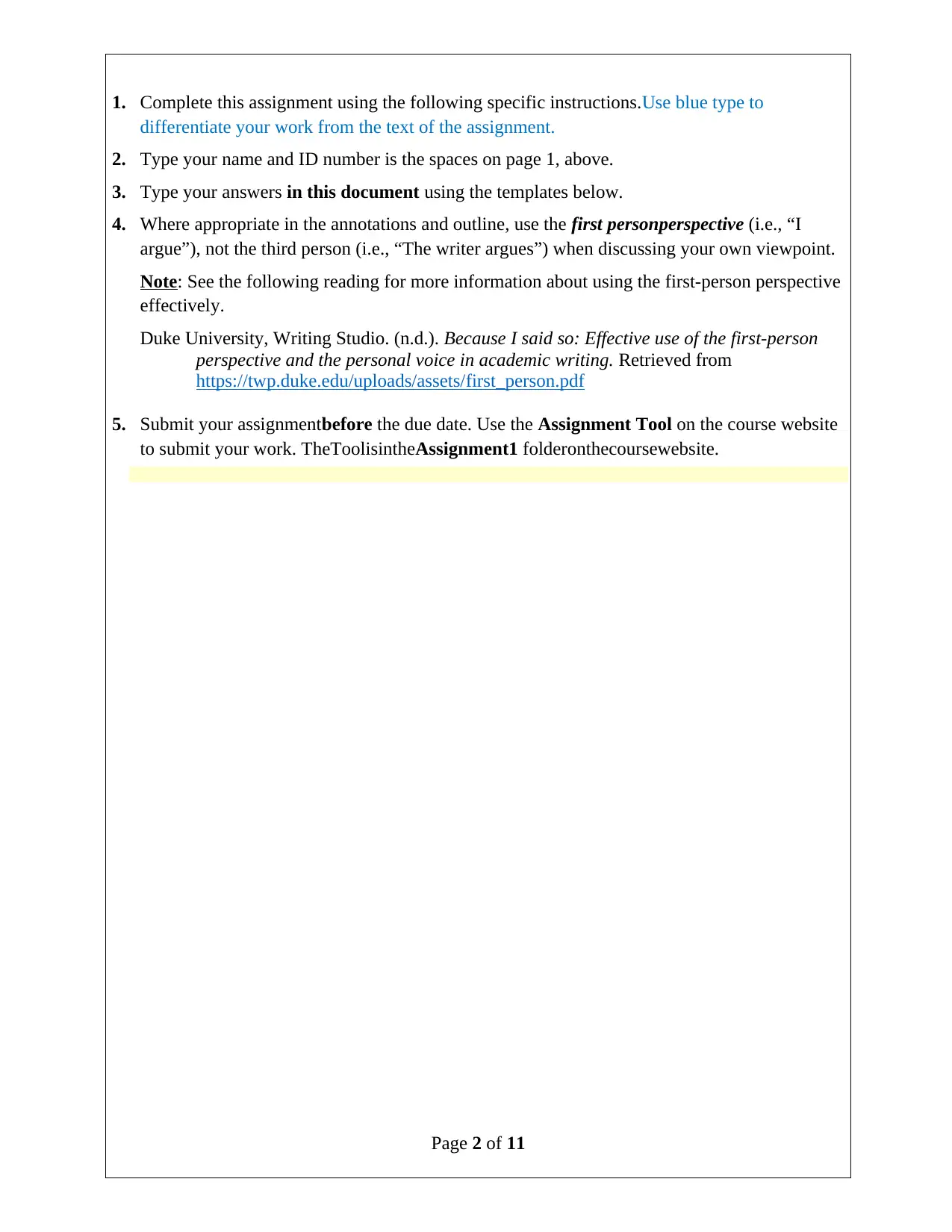
1. Complete this assignment using the following specific instructions.Use blue type to
differentiate your work from the text of the assignment.
2. Type your name and ID number is the spaces on page 1, above.
3. Type your answers in this document using the templates below.
4. Where appropriate in the annotations and outline, use the first personperspective (i.e., “I
argue”), not the third person (i.e., “The writer argues”) when discussing your own viewpoint.
Note: See the following reading for more information about using the first-person perspective
effectively.
Duke University, Writing Studio. (n.d.). Because I said so: Effective use of the first-person
perspective and the personal voice in academic writing. Retrieved from
https://twp.duke.edu/uploads/assets/first_person.pdf
5. Submit your assignmentbefore the due date. Use the Assignment Tool on the course website
to submit your work. TheToolisintheAssignment1 folderonthecoursewebsite.
Page 2 of 11
differentiate your work from the text of the assignment.
2. Type your name and ID number is the spaces on page 1, above.
3. Type your answers in this document using the templates below.
4. Where appropriate in the annotations and outline, use the first personperspective (i.e., “I
argue”), not the third person (i.e., “The writer argues”) when discussing your own viewpoint.
Note: See the following reading for more information about using the first-person perspective
effectively.
Duke University, Writing Studio. (n.d.). Because I said so: Effective use of the first-person
perspective and the personal voice in academic writing. Retrieved from
https://twp.duke.edu/uploads/assets/first_person.pdf
5. Submit your assignmentbefore the due date. Use the Assignment Tool on the course website
to submit your work. TheToolisintheAssignment1 folderonthecoursewebsite.
Page 2 of 11

Part A - Annotated BibliographyInstructions
Instructions
Step 1 – Write your revised thesis statement. See the specific instructions in the
template, below.
Step 2 – Cite sources on the pro side. Provide correctly formatted APA citations
for three articles, books, websites, videos, etc. on the pro side of the issue debate. You
may use resources you cited in your discussion exercises.
Note:At least one of your resources on each side of the debate must be an academic journal
article.
Note: Consult the Concise Rules of APA Style as necessary. The blue text below provides a
template for journal articles with DOIs.
Note: Make sure that you incorporate feedback from previous discussion exercises into this
assignment. That means you should correct any mistakes that the course professor pointed out in
your previous citations (e.g., capitalization, italicization, spelling, formatting, etc.).
Step 3 - Cite sources on the con side.Provide correctly formatted APA citations for
three articles, books, websites, videos, etc. on the con side of the issue debate. You may
use resources you cited in your discussion exercises, or you may use different, relevant
resources.
Note: The same requirements for citing pro resources apply to citing con resources (see Step 4,
above).
Step 4 - Write the annotations. Under each citation (i.e., pro and con) and following
APA rules, type your annotations. For examples, see the required resources listed in the
Course Schedule and the following resource.
Purdue Online Writing Lab. (2016). Annotated bibliography samples. Retrieved
fromhttps://owl.english.purdue.edu/owl/resource/614/03/
Page 3 of 11
Instructions
Step 1 – Write your revised thesis statement. See the specific instructions in the
template, below.
Step 2 – Cite sources on the pro side. Provide correctly formatted APA citations
for three articles, books, websites, videos, etc. on the pro side of the issue debate. You
may use resources you cited in your discussion exercises.
Note:At least one of your resources on each side of the debate must be an academic journal
article.
Note: Consult the Concise Rules of APA Style as necessary. The blue text below provides a
template for journal articles with DOIs.
Note: Make sure that you incorporate feedback from previous discussion exercises into this
assignment. That means you should correct any mistakes that the course professor pointed out in
your previous citations (e.g., capitalization, italicization, spelling, formatting, etc.).
Step 3 - Cite sources on the con side.Provide correctly formatted APA citations for
three articles, books, websites, videos, etc. on the con side of the issue debate. You may
use resources you cited in your discussion exercises, or you may use different, relevant
resources.
Note: The same requirements for citing pro resources apply to citing con resources (see Step 4,
above).
Step 4 - Write the annotations. Under each citation (i.e., pro and con) and following
APA rules, type your annotations. For examples, see the required resources listed in the
Course Schedule and the following resource.
Purdue Online Writing Lab. (2016). Annotated bibliography samples. Retrieved
fromhttps://owl.english.purdue.edu/owl/resource/614/03/
Page 3 of 11
⊘ This is a preview!⊘
Do you want full access?
Subscribe today to unlock all pages.

Trusted by 1+ million students worldwide
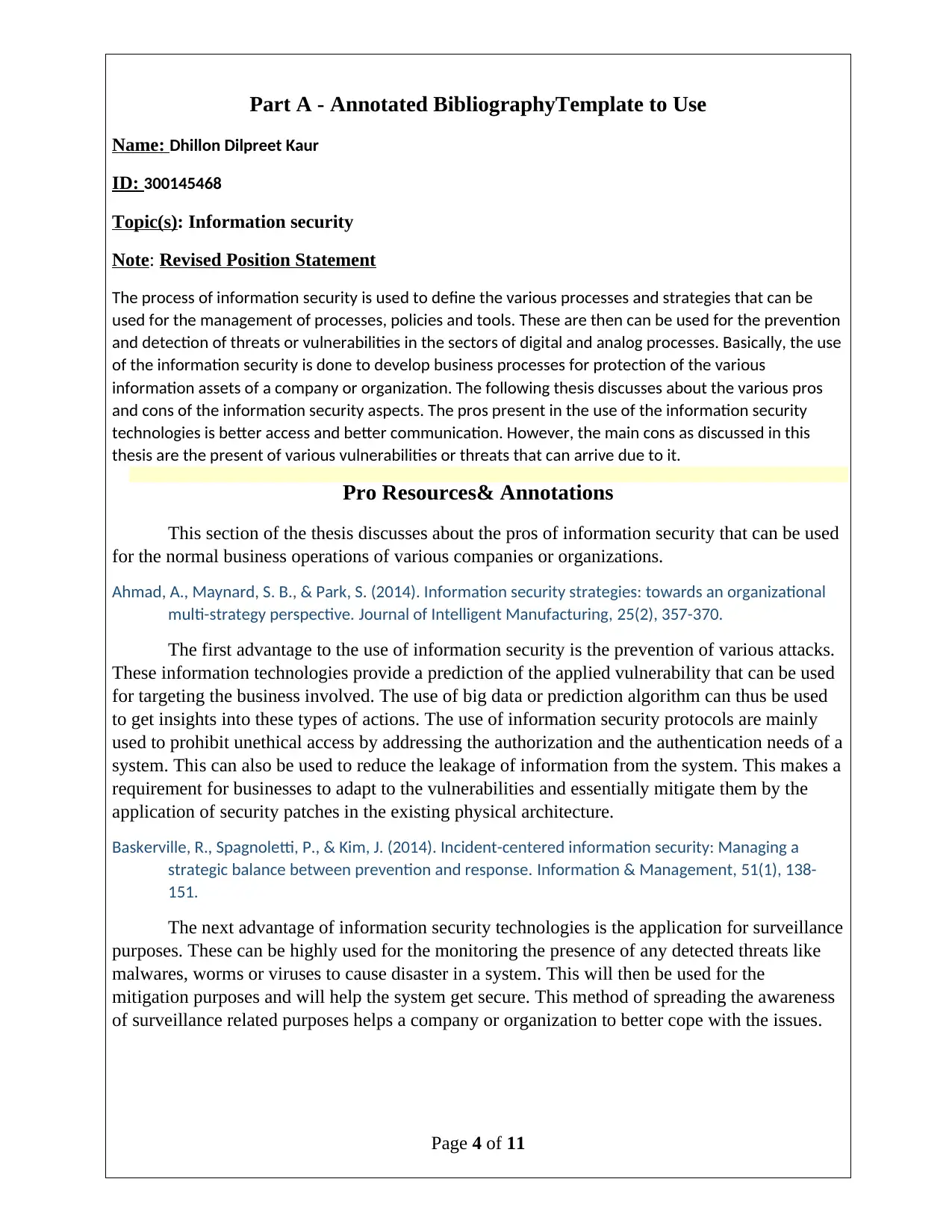
Part A - Annotated BibliographyTemplate to Use
Name: Dhillon Dilpreet Kaur
ID: 300145468
Topic(s): Information security
Note: Revised Position Statement
The process of information security is used to define the various processes and strategies that can be
used for the management of processes, policies and tools. These are then can be used for the prevention
and detection of threats or vulnerabilities in the sectors of digital and analog processes. Basically, the use
of the information security is done to develop business processes for protection of the various
information assets of a company or organization. The following thesis discusses about the various pros
and cons of the information security aspects. The pros present in the use of the information security
technologies is better access and better communication. However, the main cons as discussed in this
thesis are the present of various vulnerabilities or threats that can arrive due to it.
Pro Resources& Annotations
This section of the thesis discusses about the pros of information security that can be used
for the normal business operations of various companies or organizations.
Ahmad, A., Maynard, S. B., & Park, S. (2014). Information security strategies: towards an organizational
multi-strategy perspective. Journal of Intelligent Manufacturing, 25(2), 357-370.
The first advantage to the use of information security is the prevention of various attacks.
These information technologies provide a prediction of the applied vulnerability that can be used
for targeting the business involved. The use of big data or prediction algorithm can thus be used
to get insights into these types of actions. The use of information security protocols are mainly
used to prohibit unethical access by addressing the authorization and the authentication needs of a
system. This can also be used to reduce the leakage of information from the system. This makes a
requirement for businesses to adapt to the vulnerabilities and essentially mitigate them by the
application of security patches in the existing physical architecture.
Baskerville, R., Spagnoletti, P., & Kim, J. (2014). Incident-centered information security: Managing a
strategic balance between prevention and response. Information & Management, 51(1), 138-
151.
The next advantage of information security technologies is the application for surveillance
purposes. These can be highly used for the monitoring the presence of any detected threats like
malwares, worms or viruses to cause disaster in a system. This will then be used for the
mitigation purposes and will help the system get secure. This method of spreading the awareness
of surveillance related purposes helps a company or organization to better cope with the issues.
Page 4 of 11
Name: Dhillon Dilpreet Kaur
ID: 300145468
Topic(s): Information security
Note: Revised Position Statement
The process of information security is used to define the various processes and strategies that can be
used for the management of processes, policies and tools. These are then can be used for the prevention
and detection of threats or vulnerabilities in the sectors of digital and analog processes. Basically, the use
of the information security is done to develop business processes for protection of the various
information assets of a company or organization. The following thesis discusses about the various pros
and cons of the information security aspects. The pros present in the use of the information security
technologies is better access and better communication. However, the main cons as discussed in this
thesis are the present of various vulnerabilities or threats that can arrive due to it.
Pro Resources& Annotations
This section of the thesis discusses about the pros of information security that can be used
for the normal business operations of various companies or organizations.
Ahmad, A., Maynard, S. B., & Park, S. (2014). Information security strategies: towards an organizational
multi-strategy perspective. Journal of Intelligent Manufacturing, 25(2), 357-370.
The first advantage to the use of information security is the prevention of various attacks.
These information technologies provide a prediction of the applied vulnerability that can be used
for targeting the business involved. The use of big data or prediction algorithm can thus be used
to get insights into these types of actions. The use of information security protocols are mainly
used to prohibit unethical access by addressing the authorization and the authentication needs of a
system. This can also be used to reduce the leakage of information from the system. This makes a
requirement for businesses to adapt to the vulnerabilities and essentially mitigate them by the
application of security patches in the existing physical architecture.
Baskerville, R., Spagnoletti, P., & Kim, J. (2014). Incident-centered information security: Managing a
strategic balance between prevention and response. Information & Management, 51(1), 138-
151.
The next advantage of information security technologies is the application for surveillance
purposes. These can be highly used for the monitoring the presence of any detected threats like
malwares, worms or viruses to cause disaster in a system. This will then be used for the
mitigation purposes and will help the system get secure. This method of spreading the awareness
of surveillance related purposes helps a company or organization to better cope with the issues.
Page 4 of 11
Paraphrase This Document
Need a fresh take? Get an instant paraphrase of this document with our AI Paraphraser
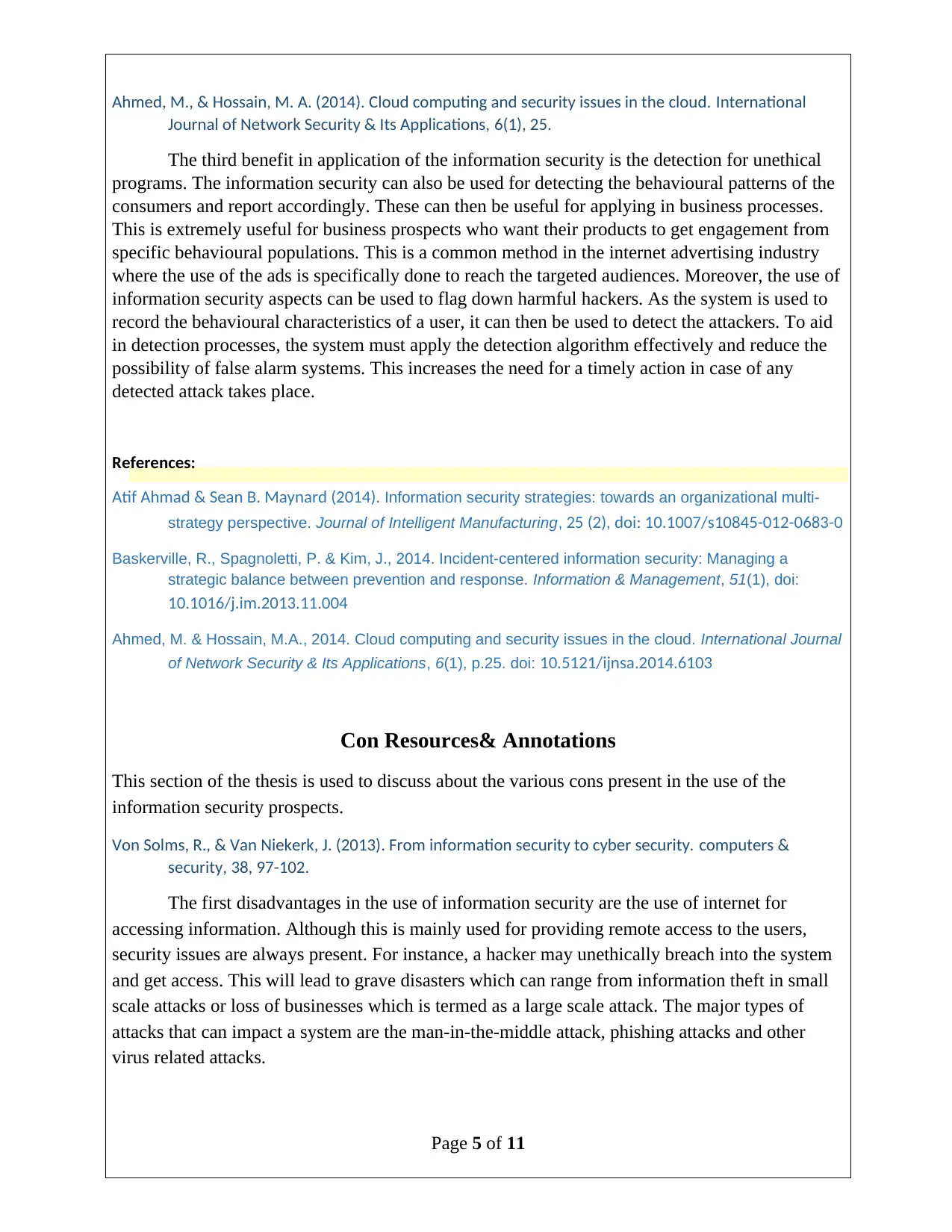
Ahmed, M., & Hossain, M. A. (2014). Cloud computing and security issues in the cloud. International
Journal of Network Security & Its Applications, 6(1), 25.
The third benefit in application of the information security is the detection for unethical
programs. The information security can also be used for detecting the behavioural patterns of the
consumers and report accordingly. These can then be useful for applying in business processes.
This is extremely useful for business prospects who want their products to get engagement from
specific behavioural populations. This is a common method in the internet advertising industry
where the use of the ads is specifically done to reach the targeted audiences. Moreover, the use of
information security aspects can be used to flag down harmful hackers. As the system is used to
record the behavioural characteristics of a user, it can then be used to detect the attackers. To aid
in detection processes, the system must apply the detection algorithm effectively and reduce the
possibility of false alarm systems. This increases the need for a timely action in case of any
detected attack takes place.
References:
Atif Ahmad & Sean B. Maynard (2014). Information security strategies: towards an organizational multi-
strategy perspective. Journal of Intelligent Manufacturing, 25 (2), doi: 10.1007/s10845-012-0683-0
Baskerville, R., Spagnoletti, P. & Kim, J., 2014. Incident-centered information security: Managing a
strategic balance between prevention and response. Information & Management, 51(1), doi:
10.1016/j.im.2013.11.004
Ahmed, M. & Hossain, M.A., 2014. Cloud computing and security issues in the cloud. International Journal
of Network Security & Its Applications, 6(1), p.25. doi: 10.5121/ijnsa.2014.6103
Con Resources& Annotations
This section of the thesis is used to discuss about the various cons present in the use of the
information security prospects.
Von Solms, R., & Van Niekerk, J. (2013). From information security to cyber security. computers &
security, 38, 97-102.
The first disadvantages in the use of information security are the use of internet for
accessing information. Although this is mainly used for providing remote access to the users,
security issues are always present. For instance, a hacker may unethically breach into the system
and get access. This will lead to grave disasters which can range from information theft in small
scale attacks or loss of businesses which is termed as a large scale attack. The major types of
attacks that can impact a system are the man-in-the-middle attack, phishing attacks and other
virus related attacks.
Page 5 of 11
Journal of Network Security & Its Applications, 6(1), 25.
The third benefit in application of the information security is the detection for unethical
programs. The information security can also be used for detecting the behavioural patterns of the
consumers and report accordingly. These can then be useful for applying in business processes.
This is extremely useful for business prospects who want their products to get engagement from
specific behavioural populations. This is a common method in the internet advertising industry
where the use of the ads is specifically done to reach the targeted audiences. Moreover, the use of
information security aspects can be used to flag down harmful hackers. As the system is used to
record the behavioural characteristics of a user, it can then be used to detect the attackers. To aid
in detection processes, the system must apply the detection algorithm effectively and reduce the
possibility of false alarm systems. This increases the need for a timely action in case of any
detected attack takes place.
References:
Atif Ahmad & Sean B. Maynard (2014). Information security strategies: towards an organizational multi-
strategy perspective. Journal of Intelligent Manufacturing, 25 (2), doi: 10.1007/s10845-012-0683-0
Baskerville, R., Spagnoletti, P. & Kim, J., 2014. Incident-centered information security: Managing a
strategic balance between prevention and response. Information & Management, 51(1), doi:
10.1016/j.im.2013.11.004
Ahmed, M. & Hossain, M.A., 2014. Cloud computing and security issues in the cloud. International Journal
of Network Security & Its Applications, 6(1), p.25. doi: 10.5121/ijnsa.2014.6103
Con Resources& Annotations
This section of the thesis is used to discuss about the various cons present in the use of the
information security prospects.
Von Solms, R., & Van Niekerk, J. (2013). From information security to cyber security. computers &
security, 38, 97-102.
The first disadvantages in the use of information security are the use of internet for
accessing information. Although this is mainly used for providing remote access to the users,
security issues are always present. For instance, a hacker may unethically breach into the system
and get access. This will lead to grave disasters which can range from information theft in small
scale attacks or loss of businesses which is termed as a large scale attack. The major types of
attacks that can impact a system are the man-in-the-middle attack, phishing attacks and other
virus related attacks.
Page 5 of 11
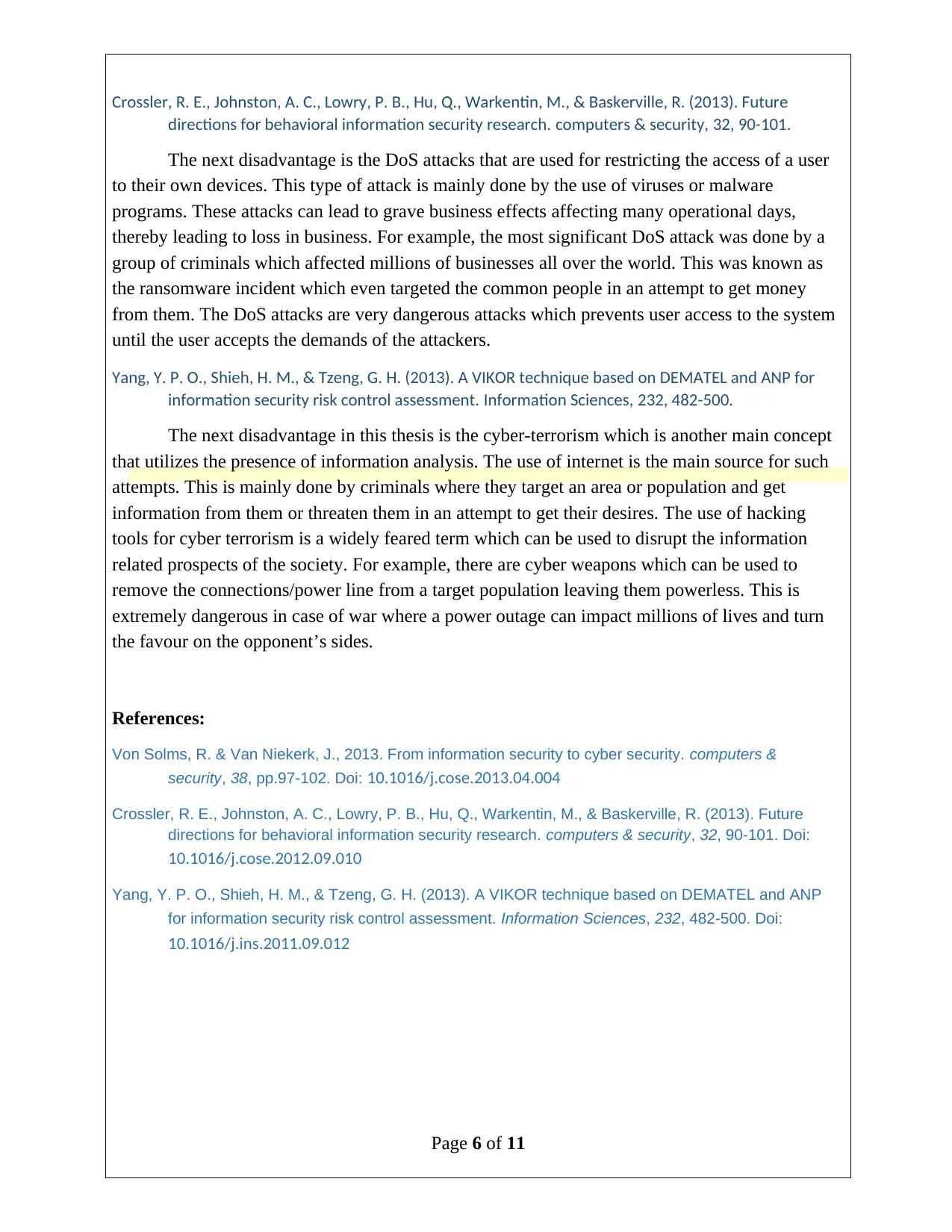
Crossler, R. E., Johnston, A. C., Lowry, P. B., Hu, Q., Warkentin, M., & Baskerville, R. (2013). Future
directions for behavioral information security research. computers & security, 32, 90-101.
The next disadvantage is the DoS attacks that are used for restricting the access of a user
to their own devices. This type of attack is mainly done by the use of viruses or malware
programs. These attacks can lead to grave business effects affecting many operational days,
thereby leading to loss in business. For example, the most significant DoS attack was done by a
group of criminals which affected millions of businesses all over the world. This was known as
the ransomware incident which even targeted the common people in an attempt to get money
from them. The DoS attacks are very dangerous attacks which prevents user access to the system
until the user accepts the demands of the attackers.
Yang, Y. P. O., Shieh, H. M., & Tzeng, G. H. (2013). A VIKOR technique based on DEMATEL and ANP for
information security risk control assessment. Information Sciences, 232, 482-500.
The next disadvantage in this thesis is the cyber-terrorism which is another main concept
that utilizes the presence of information analysis. The use of internet is the main source for such
attempts. This is mainly done by criminals where they target an area or population and get
information from them or threaten them in an attempt to get their desires. The use of hacking
tools for cyber terrorism is a widely feared term which can be used to disrupt the information
related prospects of the society. For example, there are cyber weapons which can be used to
remove the connections/power line from a target population leaving them powerless. This is
extremely dangerous in case of war where a power outage can impact millions of lives and turn
the favour on the opponent’s sides.
References:
Von Solms, R. & Van Niekerk, J., 2013. From information security to cyber security. computers &
security, 38, pp.97-102. Doi: 10.1016/j.cose.2013.04.004
Crossler, R. E., Johnston, A. C., Lowry, P. B., Hu, Q., Warkentin, M., & Baskerville, R. (2013). Future
directions for behavioral information security research. computers & security, 32, 90-101. Doi:
10.1016/j.cose.2012.09.010
Yang, Y. P. O., Shieh, H. M., & Tzeng, G. H. (2013). A VIKOR technique based on DEMATEL and ANP
for information security risk control assessment. Information Sciences, 232, 482-500. Doi:
10.1016/j.ins.2011.09.012
Page 6 of 11
directions for behavioral information security research. computers & security, 32, 90-101.
The next disadvantage is the DoS attacks that are used for restricting the access of a user
to their own devices. This type of attack is mainly done by the use of viruses or malware
programs. These attacks can lead to grave business effects affecting many operational days,
thereby leading to loss in business. For example, the most significant DoS attack was done by a
group of criminals which affected millions of businesses all over the world. This was known as
the ransomware incident which even targeted the common people in an attempt to get money
from them. The DoS attacks are very dangerous attacks which prevents user access to the system
until the user accepts the demands of the attackers.
Yang, Y. P. O., Shieh, H. M., & Tzeng, G. H. (2013). A VIKOR technique based on DEMATEL and ANP for
information security risk control assessment. Information Sciences, 232, 482-500.
The next disadvantage in this thesis is the cyber-terrorism which is another main concept
that utilizes the presence of information analysis. The use of internet is the main source for such
attempts. This is mainly done by criminals where they target an area or population and get
information from them or threaten them in an attempt to get their desires. The use of hacking
tools for cyber terrorism is a widely feared term which can be used to disrupt the information
related prospects of the society. For example, there are cyber weapons which can be used to
remove the connections/power line from a target population leaving them powerless. This is
extremely dangerous in case of war where a power outage can impact millions of lives and turn
the favour on the opponent’s sides.
References:
Von Solms, R. & Van Niekerk, J., 2013. From information security to cyber security. computers &
security, 38, pp.97-102. Doi: 10.1016/j.cose.2013.04.004
Crossler, R. E., Johnston, A. C., Lowry, P. B., Hu, Q., Warkentin, M., & Baskerville, R. (2013). Future
directions for behavioral information security research. computers & security, 32, 90-101. Doi:
10.1016/j.cose.2012.09.010
Yang, Y. P. O., Shieh, H. M., & Tzeng, G. H. (2013). A VIKOR technique based on DEMATEL and ANP
for information security risk control assessment. Information Sciences, 232, 482-500. Doi:
10.1016/j.ins.2011.09.012
Page 6 of 11
⊘ This is a preview!⊘
Do you want full access?
Subscribe today to unlock all pages.

Trusted by 1+ million students worldwide

Part A - Annotated Bibliography - Evaluation Criteria Breakdown (50 marks)
Revised Position/thesis Statement (10 marks)
statement follows two-step method studied in class
statement demonstrates commitment to specific topic(s)
statement identifies two sides of an issue debate
statement incorporates any feedback provided by the instructor
statement is clear, concise, and grammatically correct
APA Citations - Pro Side (5 marks)
half a mark will be deducted for every technical error (e.g., incorrect spelling, incorrect or
missing information, incorrect punctuation, incorrect italics)
one mark will be deducted if one of the citations is not an academic journal article
one mark will be deducted for each citation that is not for a pro side resource
Annotations - Pro Side (15 marks)
each annotation accurately summarizes the content of the resource
each annotation clearly defines the value of the resource in relation to the thesis of the
position paper
each annotation clearly indicates how the writer will use the resource within the
position paper
annotations are clear, concise, and grammatically and mechanically correct
APA Citations - Con Side (5 marks)
half a mark will be deducted for every technical error (e.g., incorrect spelling, incorrect or
missing information, incorrect punctuation, incorrect italics)
one mark will be deducted if one of the citations is not an academic journal article
one mark will be deducted for each citation that is not for a con side resource
Annotations - Con Side (15 marks)
each annotation accurately summarizes the content of the resource
each annotation clearly defines the value of the resource in relation to the thesis of the
position paper
each annotation clearly indicates how the writer will use the resource within the
position paper
annotations are clear, concise, and grammatically and mechanically correct
Page 7 of 11
Revised Position/thesis Statement (10 marks)
statement follows two-step method studied in class
statement demonstrates commitment to specific topic(s)
statement identifies two sides of an issue debate
statement incorporates any feedback provided by the instructor
statement is clear, concise, and grammatically correct
APA Citations - Pro Side (5 marks)
half a mark will be deducted for every technical error (e.g., incorrect spelling, incorrect or
missing information, incorrect punctuation, incorrect italics)
one mark will be deducted if one of the citations is not an academic journal article
one mark will be deducted for each citation that is not for a pro side resource
Annotations - Pro Side (15 marks)
each annotation accurately summarizes the content of the resource
each annotation clearly defines the value of the resource in relation to the thesis of the
position paper
each annotation clearly indicates how the writer will use the resource within the
position paper
annotations are clear, concise, and grammatically and mechanically correct
APA Citations - Con Side (5 marks)
half a mark will be deducted for every technical error (e.g., incorrect spelling, incorrect or
missing information, incorrect punctuation, incorrect italics)
one mark will be deducted if one of the citations is not an academic journal article
one mark will be deducted for each citation that is not for a con side resource
Annotations - Con Side (15 marks)
each annotation accurately summarizes the content of the resource
each annotation clearly defines the value of the resource in relation to the thesis of the
position paper
each annotation clearly indicates how the writer will use the resource within the
position paper
annotations are clear, concise, and grammatically and mechanically correct
Page 7 of 11
Paraphrase This Document
Need a fresh take? Get an instant paraphrase of this document with our AI Paraphraser
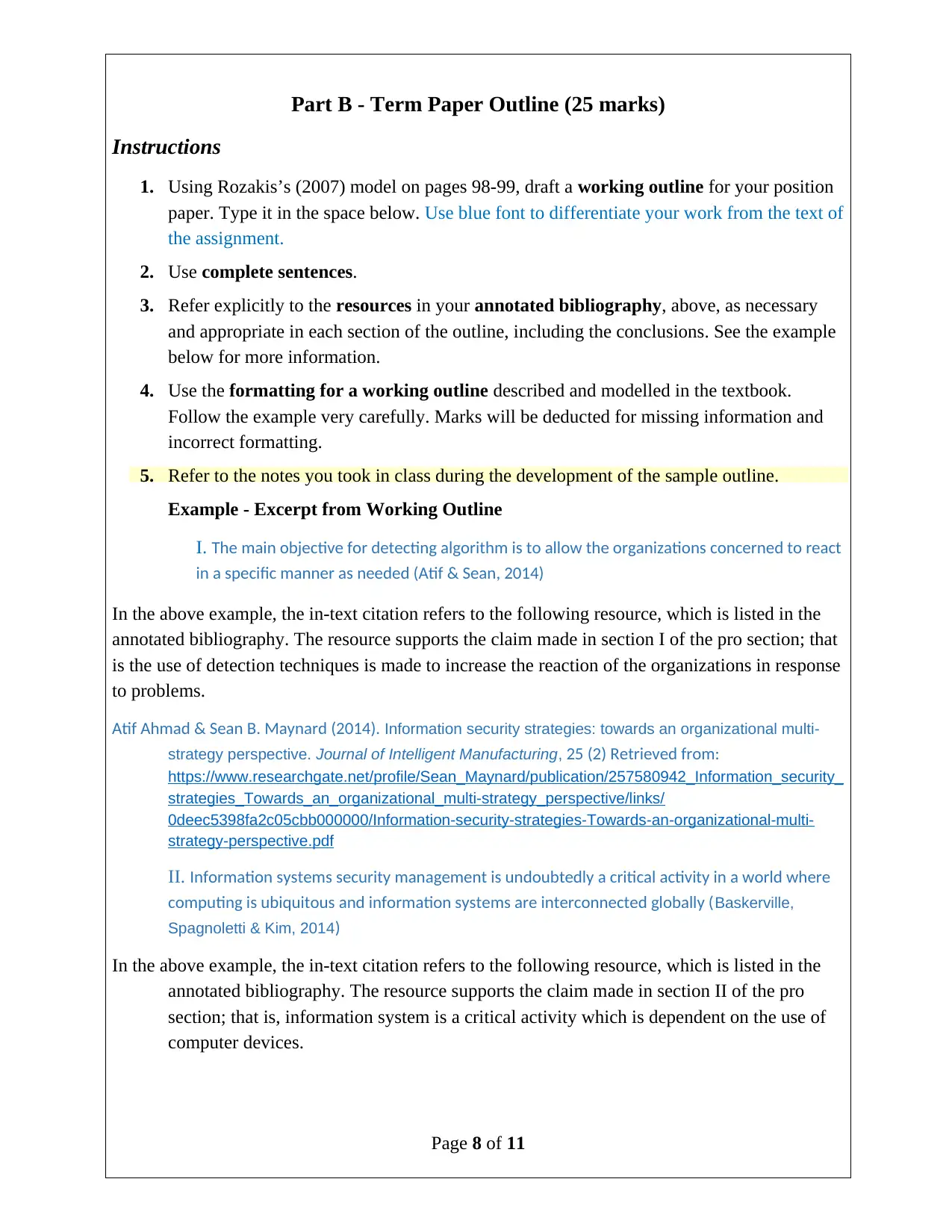
Part B - Term Paper Outline (25 marks)
Instructions
1. Using Rozakis’s (2007) model on pages 98-99, draft a working outline for your position
paper. Type it in the space below. Use blue font to differentiate your work from the text of
the assignment.
2. Use complete sentences.
3. Refer explicitly to the resources in your annotated bibliography, above, as necessary
and appropriate in each section of the outline, including the conclusions. See the example
below for more information.
4. Use the formatting for a working outline described and modelled in the textbook.
Follow the example very carefully. Marks will be deducted for missing information and
incorrect formatting.
5. Refer to the notes you took in class during the development of the sample outline.
Example - Excerpt from Working Outline
I. The main objective for detecting algorithm is to allow the organizations concerned to react
in a specific manner as needed (Atif & Sean, 2014)
In the above example, the in-text citation refers to the following resource, which is listed in the
annotated bibliography. The resource supports the claim made in section I of the pro section; that
is the use of detection techniques is made to increase the reaction of the organizations in response
to problems.
Atif Ahmad & Sean B. Maynard (2014). Information security strategies: towards an organizational multi-
strategy perspective. Journal of Intelligent Manufacturing, 25 (2) Retrieved from:
https://www.researchgate.net/profile/Sean_Maynard/publication/257580942_Information_security_
strategies_Towards_an_organizational_multi-strategy_perspective/links/
0deec5398fa2c05cbb000000/Information-security-strategies-Towards-an-organizational-multi-
strategy-perspective.pdf
II. Information systems security management is undoubtedly a critical activity in a world where
computing is ubiquitous and information systems are interconnected globally (Baskerville,
Spagnoletti & Kim, 2014)
In the above example, the in-text citation refers to the following resource, which is listed in the
annotated bibliography. The resource supports the claim made in section II of the pro
section; that is, information system is a critical activity which is dependent on the use of
computer devices.
Page 8 of 11
Instructions
1. Using Rozakis’s (2007) model on pages 98-99, draft a working outline for your position
paper. Type it in the space below. Use blue font to differentiate your work from the text of
the assignment.
2. Use complete sentences.
3. Refer explicitly to the resources in your annotated bibliography, above, as necessary
and appropriate in each section of the outline, including the conclusions. See the example
below for more information.
4. Use the formatting for a working outline described and modelled in the textbook.
Follow the example very carefully. Marks will be deducted for missing information and
incorrect formatting.
5. Refer to the notes you took in class during the development of the sample outline.
Example - Excerpt from Working Outline
I. The main objective for detecting algorithm is to allow the organizations concerned to react
in a specific manner as needed (Atif & Sean, 2014)
In the above example, the in-text citation refers to the following resource, which is listed in the
annotated bibliography. The resource supports the claim made in section I of the pro section; that
is the use of detection techniques is made to increase the reaction of the organizations in response
to problems.
Atif Ahmad & Sean B. Maynard (2014). Information security strategies: towards an organizational multi-
strategy perspective. Journal of Intelligent Manufacturing, 25 (2) Retrieved from:
https://www.researchgate.net/profile/Sean_Maynard/publication/257580942_Information_security_
strategies_Towards_an_organizational_multi-strategy_perspective/links/
0deec5398fa2c05cbb000000/Information-security-strategies-Towards-an-organizational-multi-
strategy-perspective.pdf
II. Information systems security management is undoubtedly a critical activity in a world where
computing is ubiquitous and information systems are interconnected globally (Baskerville,
Spagnoletti & Kim, 2014)
In the above example, the in-text citation refers to the following resource, which is listed in the
annotated bibliography. The resource supports the claim made in section II of the pro
section; that is, information system is a critical activity which is dependent on the use of
computer devices.
Page 8 of 11
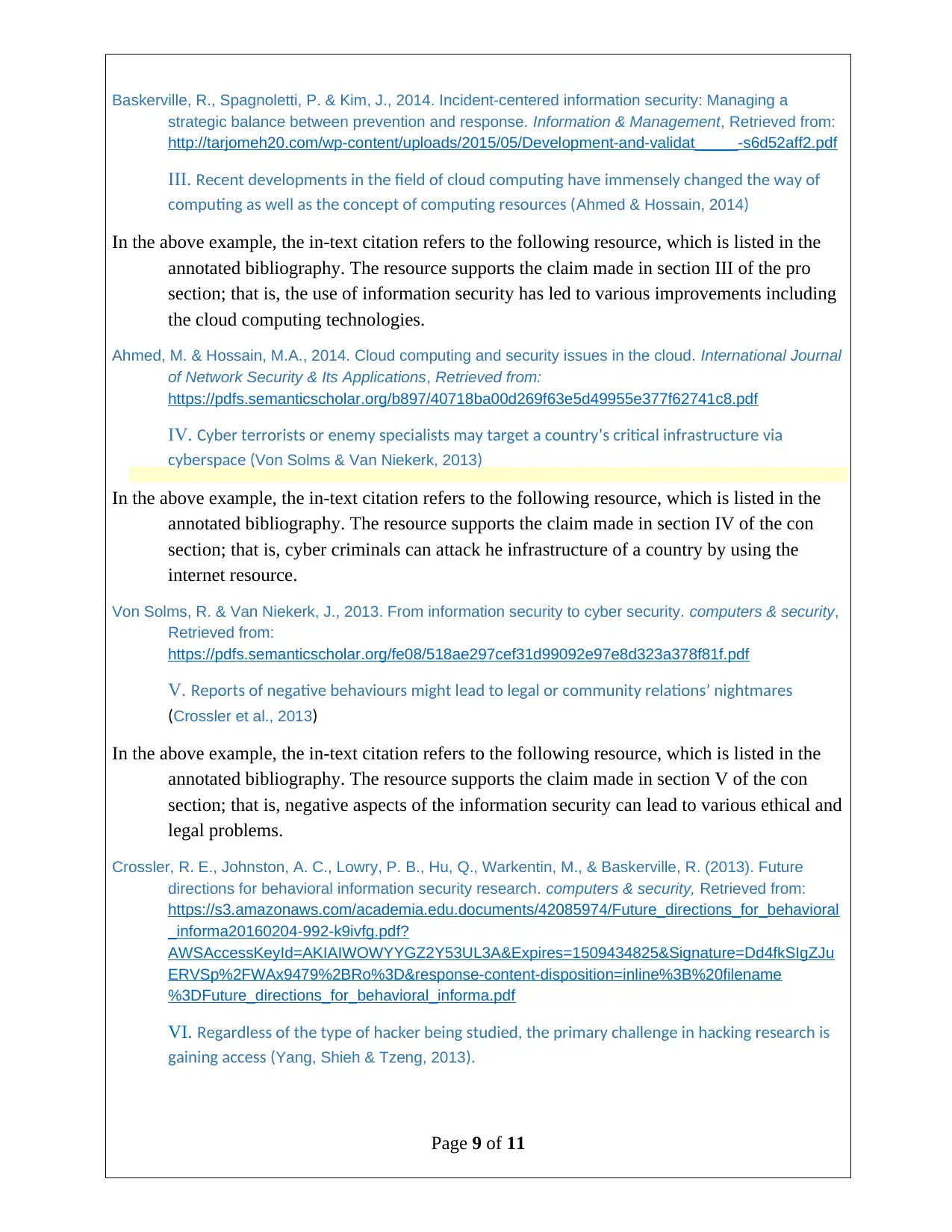
Baskerville, R., Spagnoletti, P. & Kim, J., 2014. Incident-centered information security: Managing a
strategic balance between prevention and response. Information & Management, Retrieved from:
http://tarjomeh20.com/wp-content/uploads/2015/05/Development-and-validat_____-s6d52aff2.pdf
III. Recent developments in the field of cloud computing have immensely changed the way of
computing as well as the concept of computing resources (Ahmed & Hossain, 2014)
In the above example, the in-text citation refers to the following resource, which is listed in the
annotated bibliography. The resource supports the claim made in section III of the pro
section; that is, the use of information security has led to various improvements including
the cloud computing technologies.
Ahmed, M. & Hossain, M.A., 2014. Cloud computing and security issues in the cloud. International Journal
of Network Security & Its Applications, Retrieved from:
https://pdfs.semanticscholar.org/b897/40718ba00d269f63e5d49955e377f62741c8.pdf
IV. Cyber terrorists or enemy specialists may target a country’s critical infrastructure via
cyberspace (Von Solms & Van Niekerk, 2013)
In the above example, the in-text citation refers to the following resource, which is listed in the
annotated bibliography. The resource supports the claim made in section IV of the con
section; that is, cyber criminals can attack he infrastructure of a country by using the
internet resource.
Von Solms, R. & Van Niekerk, J., 2013. From information security to cyber security. computers & security,
Retrieved from:
https://pdfs.semanticscholar.org/fe08/518ae297cef31d99092e97e8d323a378f81f.pdf
V. Reports of negative behaviours might lead to legal or community relations’ nightmares
(Crossler et al., 2013)
In the above example, the in-text citation refers to the following resource, which is listed in the
annotated bibliography. The resource supports the claim made in section V of the con
section; that is, negative aspects of the information security can lead to various ethical and
legal problems.
Crossler, R. E., Johnston, A. C., Lowry, P. B., Hu, Q., Warkentin, M., & Baskerville, R. (2013). Future
directions for behavioral information security research. computers & security, Retrieved from:
https://s3.amazonaws.com/academia.edu.documents/42085974/Future_directions_for_behavioral
_informa20160204-992-k9ivfg.pdf?
AWSAccessKeyId=AKIAIWOWYYGZ2Y53UL3A&Expires=1509434825&Signature=Dd4fkSIgZJu
ERVSp%2FWAx9479%2BRo%3D&response-content-disposition=inline%3B%20filename
%3DFuture_directions_for_behavioral_informa.pdf
VI. Regardless of the type of hacker being studied, the primary challenge in hacking research is
gaining access (Yang, Shieh & Tzeng, 2013).
Page 9 of 11
strategic balance between prevention and response. Information & Management, Retrieved from:
http://tarjomeh20.com/wp-content/uploads/2015/05/Development-and-validat_____-s6d52aff2.pdf
III. Recent developments in the field of cloud computing have immensely changed the way of
computing as well as the concept of computing resources (Ahmed & Hossain, 2014)
In the above example, the in-text citation refers to the following resource, which is listed in the
annotated bibliography. The resource supports the claim made in section III of the pro
section; that is, the use of information security has led to various improvements including
the cloud computing technologies.
Ahmed, M. & Hossain, M.A., 2014. Cloud computing and security issues in the cloud. International Journal
of Network Security & Its Applications, Retrieved from:
https://pdfs.semanticscholar.org/b897/40718ba00d269f63e5d49955e377f62741c8.pdf
IV. Cyber terrorists or enemy specialists may target a country’s critical infrastructure via
cyberspace (Von Solms & Van Niekerk, 2013)
In the above example, the in-text citation refers to the following resource, which is listed in the
annotated bibliography. The resource supports the claim made in section IV of the con
section; that is, cyber criminals can attack he infrastructure of a country by using the
internet resource.
Von Solms, R. & Van Niekerk, J., 2013. From information security to cyber security. computers & security,
Retrieved from:
https://pdfs.semanticscholar.org/fe08/518ae297cef31d99092e97e8d323a378f81f.pdf
V. Reports of negative behaviours might lead to legal or community relations’ nightmares
(Crossler et al., 2013)
In the above example, the in-text citation refers to the following resource, which is listed in the
annotated bibliography. The resource supports the claim made in section V of the con
section; that is, negative aspects of the information security can lead to various ethical and
legal problems.
Crossler, R. E., Johnston, A. C., Lowry, P. B., Hu, Q., Warkentin, M., & Baskerville, R. (2013). Future
directions for behavioral information security research. computers & security, Retrieved from:
https://s3.amazonaws.com/academia.edu.documents/42085974/Future_directions_for_behavioral
_informa20160204-992-k9ivfg.pdf?
AWSAccessKeyId=AKIAIWOWYYGZ2Y53UL3A&Expires=1509434825&Signature=Dd4fkSIgZJu
ERVSp%2FWAx9479%2BRo%3D&response-content-disposition=inline%3B%20filename
%3DFuture_directions_for_behavioral_informa.pdf
VI. Regardless of the type of hacker being studied, the primary challenge in hacking research is
gaining access (Yang, Shieh & Tzeng, 2013).
Page 9 of 11
⊘ This is a preview!⊘
Do you want full access?
Subscribe today to unlock all pages.

Trusted by 1+ million students worldwide
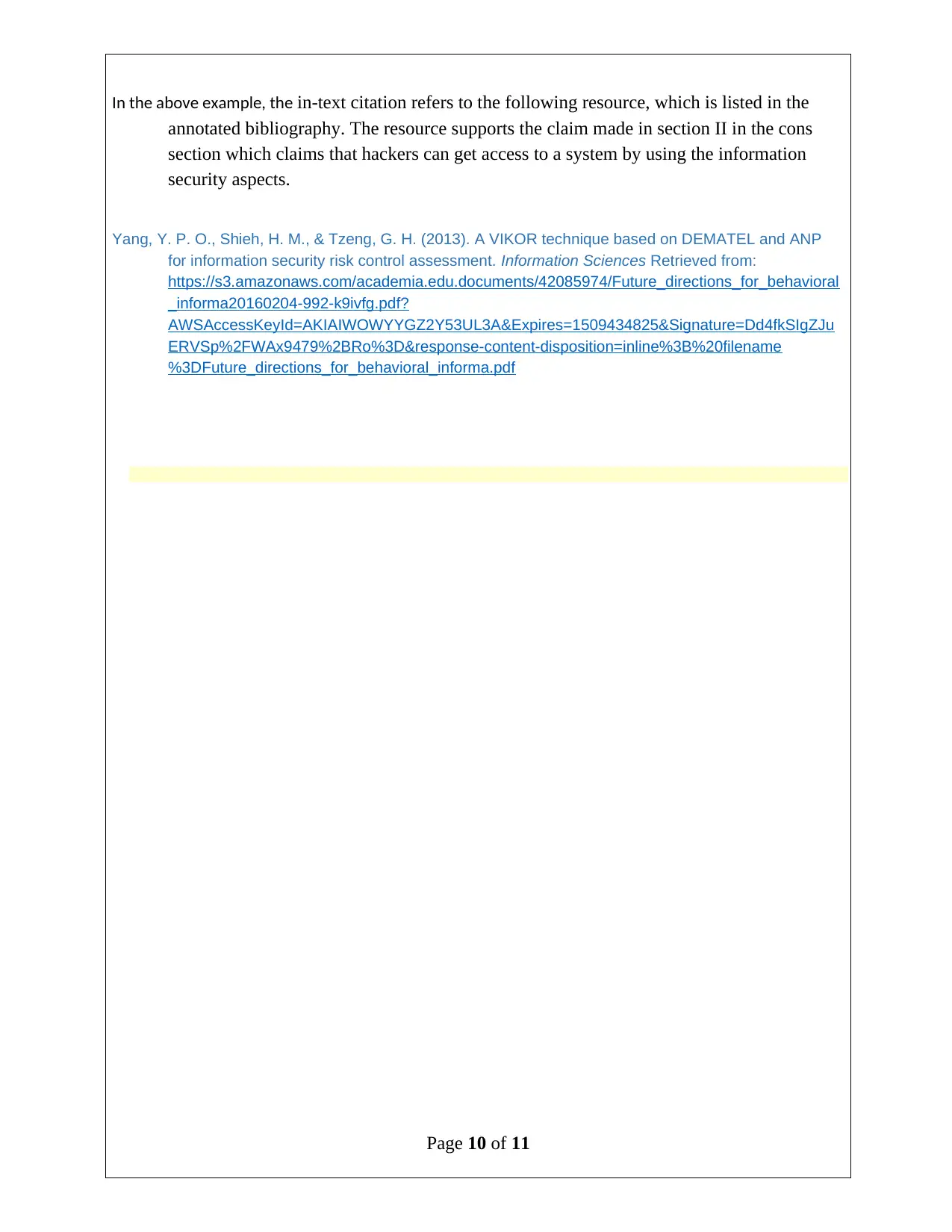
In the above example, the in-text citation refers to the following resource, which is listed in the
annotated bibliography. The resource supports the claim made in section II in the cons
section which claims that hackers can get access to a system by using the information
security aspects.
Yang, Y. P. O., Shieh, H. M., & Tzeng, G. H. (2013). A VIKOR technique based on DEMATEL and ANP
for information security risk control assessment. Information Sciences Retrieved from:
https://s3.amazonaws.com/academia.edu.documents/42085974/Future_directions_for_behavioral
_informa20160204-992-k9ivfg.pdf?
AWSAccessKeyId=AKIAIWOWYYGZ2Y53UL3A&Expires=1509434825&Signature=Dd4fkSIgZJu
ERVSp%2FWAx9479%2BRo%3D&response-content-disposition=inline%3B%20filename
%3DFuture_directions_for_behavioral_informa.pdf
Page 10 of 11
annotated bibliography. The resource supports the claim made in section II in the cons
section which claims that hackers can get access to a system by using the information
security aspects.
Yang, Y. P. O., Shieh, H. M., & Tzeng, G. H. (2013). A VIKOR technique based on DEMATEL and ANP
for information security risk control assessment. Information Sciences Retrieved from:
https://s3.amazonaws.com/academia.edu.documents/42085974/Future_directions_for_behavioral
_informa20160204-992-k9ivfg.pdf?
AWSAccessKeyId=AKIAIWOWYYGZ2Y53UL3A&Expires=1509434825&Signature=Dd4fkSIgZJu
ERVSp%2FWAx9479%2BRo%3D&response-content-disposition=inline%3B%20filename
%3DFuture_directions_for_behavioral_informa.pdf
Page 10 of 11
Paraphrase This Document
Need a fresh take? Get an instant paraphrase of this document with our AI Paraphraser

Part B - Term Paper Outline - Evaluation Criteria
Criteria Value
1. Document is a working outline, as discussed by Rozakis (2007) 2 marks
2. Outline supports the revised thesis statement 5 marks
3. Outline presents arguments clearly and logically 5 marks
4. Entries are written in complete sentencesthat are grammatically and
mechanicallycorrect
5 marks
5. Entries are supported, as necessary and appropriate, by in-text
citations
5 marks
6. Outline follows the correct formatting, as discussed by Rozakis (2007) 3 marks
Total 25 marks
END OF ASSIGNMENT
Page 11 of 11
Criteria Value
1. Document is a working outline, as discussed by Rozakis (2007) 2 marks
2. Outline supports the revised thesis statement 5 marks
3. Outline presents arguments clearly and logically 5 marks
4. Entries are written in complete sentencesthat are grammatically and
mechanicallycorrect
5 marks
5. Entries are supported, as necessary and appropriate, by in-text
citations
5 marks
6. Outline follows the correct formatting, as discussed by Rozakis (2007) 3 marks
Total 25 marks
END OF ASSIGNMENT
Page 11 of 11
1 out of 11
Related Documents
Your All-in-One AI-Powered Toolkit for Academic Success.
+13062052269
info@desklib.com
Available 24*7 on WhatsApp / Email
![[object Object]](/_next/static/media/star-bottom.7253800d.svg)
Unlock your academic potential
© 2024 | Zucol Services PVT LTD | All rights reserved.




